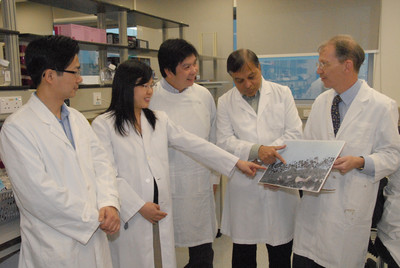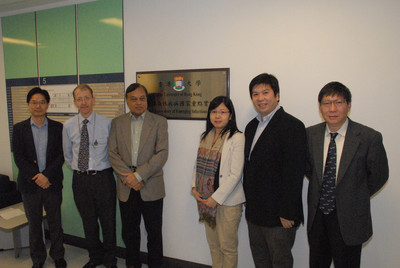HKU finds novel coronavirus can infect humans respiratory tract even better than SARS-CoV
08 Apr 2013
HKU research team reveals the how the novel coronavirus (HCoV-EMC) causes disease in human respiratory tract and the potential options for clinical treatment. By using human lung tissues maintained in culture, the researchers discover that the novel coronavirus is as virulent or more virulent that SARS coronavirus in causing lung damage. This research has recently been published in the international virology journal, Journal of Virology.
Researchers at the Centre of Influenza Research of the School of Public Health, the Department of Pathology and the State Key Laboratory of Emerging Infectious Diseases of The University of Hong Kong Li Ka Shing Faculty of Medicine, lead the research. One of the key members of the team, Dr Michael Chan Chi-wai, Assistant Professor of the School of Public Health says, “How HCoV-EMC causes severe disease and death in humans is still unknown. We have made use of our human lung ex vivo explant culture system to show for the first time how the novel coronavirus cause human disease in lung and how it may spread to other organs. Our team also finds that interferon treatment can suppress the virus infection in the lung. It brings insight to potential treatment strategies for the novel coronavirus.”
Research findings
The researchers use human lung tissues maintained in culture to compare infection with the novel coronavirus (HCoV-EMC), SARS coronavirus (SARS-CoV) and the common cold virus 229E. They find that the novel coronavirus infects and replicates in human alveolar type I and type II epithelial cells in the lung and it multiplies even faster than the SARS coronavirus causing severe lung injury.
Type I alveolar epithelial cells are crucial for oxygen exchange in the lungs and damage to these cells leads to difficulty in breathing. Type II alveolar epithelial cells are the key cell for regeneration and repair of damaged lung tissues and damage to these cells will prevent repair processes that allow the lung to recover from injury or infection.
Taken together, this explains the severe pneumonia caused by this virus and the severity of disease. It further shows that the novel HCoV-EMV is as virulent or more virulent than SARS-CoV in causing lung damage. They also point out that the virus infects the cells lining the blood vessels of the lung (endothelial cells), suggesting that the virus may spread through the blood stream to affect organs distant from the respiratory tract.
To explore the possible treatment strategies, the research also addresses the pathogenesis of the novel coronavirus. The result demonstrates that the novel coronavirus avoids activating the human lung interferon responses, which are the first-line host defense system to defend against viral infection, and allows the virus to continue to replicate and cause damage to the lung. On the other hand, the virus infection in the lung can be suppressed by interferon treatment, suggesting that this is a treatment option that may be beneficial in treating humans with novel coronavirus infected disease.
Research background
Since April 2012, there have been 17 laboratory-confirmed human cases and 11 of these patients died from the respiratory disease associated with a newly recognized human betacoronavirus in lineage C (HCoV-EMC) virus. The infected patients come from Jordan, Saudi Arabia, Qatar, the United Kingdom and the United Arab Emirates. The transmissibility and pathogenesis of the novel coronavirus remains poorly understood so far.
About the research team
This research was led by Professor Malik Peiris, Chair Professor Virology and Professor (Clinical) and Dr Michael Chan Chi-wai, Assistant Professor, in collaboration with Professor Guan Yi, Professor, Dr Leo Poon Lit-man, Associate Professor and Dr Renee Chan Wan-yi, Honorary Assistant Professor from the Centre of Influenza Research and the School of Public Health; and Professor John Nicholls, Clinical Professor of The Department of Pathology, HKU Li Ka Shing Faculty of Medicine. Professor Ralph Baric at The University of North Carolina, Chapel Hill, North Carolina, USA provided crucial antibody reagents.
To use the press release photo(s) for any publishing, publicity and related purpose, photo courtesy should be given to “Li Ka Shing Faculty of Medicine, The University of Hong Kong”

The University of Hong Kong Li Ka Shing Faculty of Medicine discovers how novel coronavirus can cause human diseases in lung and how it may spread to other organs for the first time. The team also finds that interferon treatment can suppress the virus infection in the lung, which brings insight to the future treatment strategy.

The research team of School of Public Health and Department of Pathology, The University of Hong Kong Li Ka Shing Faculty of Medicine (from the left): Dr Leo Poon Lit-man, Associate Professor; Professor John Nicholls, Clinical Professor; Professor Malik Peiris, Chair Professor of Virology; Dr Renee Chan Wan-yi, Honorary Assistant Professor, Dr Michael Chan Chi-wai, Assistant Professor and Professor Guan Yi, Professor.

The University of Hong Kong Li Ka Shing Faculty of Medicine’s study finds that, novel coronavirus can infect the cells responsible for oxygen exchange in the lung. It can also spread from the lung to other organs, and the rate of replication is much faster than SARS.
